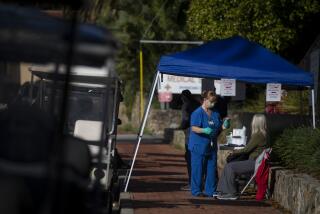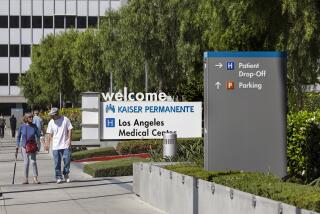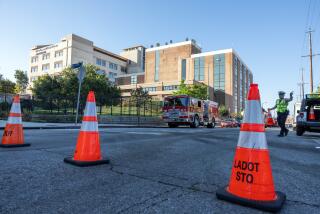Inspectors found problems persisted at Pasadena psychiatric hospital
Those seeking treatment at Aurora Las Encinas Hospital pass through manicured gardens on their way to a facility that costs as much as $1,400 a night. For the money, the private Pasadena psychiatric hospital promises world-renowned care and privacy, with a decades-long reputation for service to the rich and famous.
In the last year, however, Las Encinas has been inspected at least six times by government regulators who have documented numerous failures in patient care, The Times has found. Despite hospital officials’ promises to fix deficiencies, many of the same problems were found by inspectors when they went back late last year to check on progress at the facility.
Among significant problems reported in documents newly released to The Times:
* A 26-year-old patient died in 2006 after staffers failed to check on him for 24 hours, despite a doctor’s orders that he be monitored “very closely.” The circumstances are very similar to a death reported last year by The Times. In both cases, Las Encinas mental health workers falsified logs to show that the patients had been checked every 15 minutes, according to government inspection reports.
* An internal memo indicates that hospital administrators knew last May that they had a problem with people sleeping at work. Diane Hobbs, the facility’s nursing director, warned staffers they could be fired if caught. Three months later, law enforcement officials told The Times that a 14-year-old female patient had been raped by a 16-year-old patient while hospital workers and the suspect’s probation officer slept nearby. Prosecutors have charged the boy with rape, and he will be tried as an adult.
* A 10-year-old boy was exposed to “cursing language as well as sexually explicit language” in a group session after he was placed in a program intended for 12- to 17-year-olds. He had been admitted for treatment after attacking his brother and threatening to jump out of a second-story window. Hospital officials admitted they erred in the placement.
* Doctors allowed a patient to remain at the hospital’s expensive and exclusive Two South unit -- which offered concierge service and a personal attendant -- even though she was no longer receiving psychiatric care. A doctor told inspectors in October that the patient, who began treatment 10 months earlier for depression and alcohol abuse, “was not acutely mentally ill” but “had the resources” to continue staying at the hospital in order to meet the terms of a court order.
* No translator was provided for a 79-year-old Vietnamese-speaking woman during group sessions and numerous other assessments, meaning that the woman, who had hallucinations, had never been fully evaluated and went without treatment.
“I stay in my room. I haven’t gone to any groups because I don’t understand English,” she told inspectors. Her son reported that at one point, a nurse called him by phone so he could “ask my mother why she was lying on the floor.”
Her case was documented by regulators after a surprise inspection of Las Encinas in late October. The inspection was done after the deaths of three patients in five months and after the reported rape of the teenage patient. The Times reported those incidents last summer.
Inspectors also faulted the hospital for using pre-printed generic treatment plans for some patients and failing to document neurological testing in others.
Regulators put Las Encinas officials on notice that the facility was in danger of losing Medicaid and Medicare funding if the problems continued.
In a plan of correction filed Dec. 11, Linda Parks, the hospital’s chief executive, promised to correct the deficiencies. Among the steps she said had already been taken: “The facility posted a notice in their lobby informing the public that interpretive services will be arranged for patients free of charge.”
Little progress
Four days after Parks filed her plan, government inspectors were back at the facility, which has 118 licensed beds. They found little progress at the 29-acre campus, according to reports obtained last week by The Times.
Despite Parks’ assurances that the hospital had been offering free translation services since late November, inspectors found an Arabic-speaking patient who had been without a translator for two weeks after his insurance company stopped paying for the service.
By then, hospital records indicate, his doctor had described the man, considered potentially homicidal and suicidal, as increasingly angry and upset. The patient could not easily express his feelings to therapists in English and was “becoming very paranoid with a lot of persecutory ideas” and was “losing a lot of hope,” according to a doctor’s note.
Inspectors who interviewed the doctor reported that no one had told him about the hospital’s promise to provide free translators. Las Encinas’ medical director later acknowledged that he had not told the staff about the change in the hospital’s policy, according to the report.
In addition, inspectors found that the hospital had continued to use pre-printed generic treatment plans despite being warned that it was a violation. Staffers were also still failing to document neurological testing.
Steve Jennings, director of business development for the hospital, said late last week that Las Encinas “was found to be in full compliance” when inspectors returned Feb. 17.
Federal regulators, however, have not yet received the newest report from state inspectors.
“Our top priority is to protect the health and safety of Medicare and Medicaid beneficiaries,” said Jack Cheevers, Medicare and Medicaid Services spokesman, who also said that “most hospitals do come into compliance” when faced with the loss of federal funds.
Parks declined to discuss patient care issues with The Times, citing patient confidentiality. But in a statement, she defended the hospital.
“It is unfortunate that the many thousands of patients and their families who have been successfully treated at Las Encinas do not have an opportunity to tell their stories to the press,” Parks wrote. “It is disappointing to realize that the only stories the media wishes to carry ignore the outstanding care we provide year after year.”
But the families of two men who died while in Las Encinas’ care said they still have many questions about what went wrong at a hospital they believed would provide world-class treatment.
Both young men wanted to be treated at Las Encinas because of its affiliation with Dr. Drew Pinsky, co-medical director of its chemical dependency unit, their families said.
Pinsky, best-known for his nationally syndicated “Loveline” radio program and his reality TV show on VH1, “Celebrity Rehab With Dr. Drew,” has been affiliated with the hospital for more than 20 years. He did not treat either man and did not respond to multiple requests for comment about the latest findings.
Last summer, Pinsky told The Times his heart was broken over the deaths there and defended the facility as an “excellent hospital.” But he seemed to distance himself from the hospital, calling it a “bizarre misconception” that people associated him with the facility.
At that time, he was the only physician whose picture was featured on the Las Encinas website. Currently, the hospital’s home page features links to two news articles that refer to Pinsky’s role at the hospital. His affiliation with Las Encinas is included in his biographical information that appears on Loveline’s website and in numerous VH1 press releases.
Pinsky’s reputation drew Alex Clyburn’s family to the private hospital, his mother said. Clyburn, a 23-year old Cal State Northridge student, sought substance abuse treatment at Las Encinas last April.
Just before he was admitted, Clyburn took a large dose of OxyContin, a painkiller, and Xanax, an anti-anxiety drug. After admission, hospital staffers gave him a mix of medications intended to ease his withdrawal. His mother, a nurse, later said she expressed concern to hospital staffers that the drugs would cause respiratory distress. She said a nurse assured her that they would check on her son through the night.
Clyburn was found dead in his room the next morning.
A mental health worker had falsified patient records showing that Clyburn was checked on every 15 minutes, investigators found. Logs filed by the worker even reported Clyburn as sleeping just five minutes before a nurse discovered his body “cold & stiff to touch with a blue face,” an indication he had been dead for some time.
The hospital said it fired the worker and promised to monitor patients undergoing detoxification closely.
What Clyburn’s family did not know was that 16 months earlier, another young man had died after going unmonitored overnight by Las Encinas staff.
Leo Grassini, 26, was found dead in his room five days after he sought treatment for addiction at the hospital shortly after Thanksgiving 2006. Like Clyburn, he had specifically told his parents he wanted to go to Las Encinas.
“He listened to ‘Loveline’ when he grew up, and Drew Pinsky worked there, and he felt that Drew Pinsky could help him with any problems he had,” said his father, Lawrence Grassini, an attorney in the San Fernando Valley.
According to medical records, Leo Grassini had been prescribed narcotic medication intended to help wean him off opiates. He was later found lethargic and with depressed breathing and was rushed to the emergency room at San Gabriel Valley Medical Center, according to records. After emergency room doctors stabilized Grassini and sent him back to the private psychiatric hospital, a Las Encinas doctor ordered that his vital signs be monitored “very closely for the next 24 hours.”
Instead, his therapist found Grassini dead in his bed the next morning. His body was discovered only after he failed to show up for a morning session. According to medical records, there were signs he had been dead for some time; his face and chest had turned purple and were cool.
Just as in Clyburn’s later death, a hospital investigation found that a mental health worker had falsified patient records to indicate that she had checked on him every 15 minutes. In Grassini’s case, hospital records showed that the worker even reported having checked on him after he had been found dead.
In reality, government inspectors said, they found no evidence that anyone ever checked to see whether Grassini was breathing that night.
In a plan of correction filed to the state nearly two years after Grassini’s death -- and five months after Clyburn’s -- hospital officials said they would place patients with “significant medical risk” undergoing detoxification in a unit “specific to their needs.” The mental health worker accused of falsifying records in Grassini’s case, the hospital reported, had been fired shortly after the incident.
By then, Lawrence Grassini had long since hired independent medical experts to review his son’s medical records. All four experts identified problems with the hospital’s handling of his son’s treatment and concluded in separate reports reviewed by The Times that Leo Grassini’s death could have been avoided.
“The failure to monitor Leo’s vital signs is an egregious departure from basic standard of care and resulted in the death of this 26-year-old man,” San Bernardino County chief medical examiner Frank Sheridan wrote in an opinion dated Oct. 27, 2007. Sheridan called for an investigation as “definitely necessary so that others may be protected from such appalling care in the future.”
‘I was shocked’
After getting the expert opinions, Lawrence Grassini, who has not sued Las Encinas, had one of his law partners send letters to state and federal regulators in November 2007 and again in March 2008, urging them to investigate Las Encinas “so that further and future predictable deaths and injuries could be avoided.”
In August, Grassini read the Times report of the deaths of Clyburn and two other patients.
“I was shocked, and mad, and so sad,” he said.
A week later, he received the results of a state investigation into his son’s case, nearly 21 months after his son died. Government inspectors faulted Las Encinas for failing to monitor the young man. Of the worker who was supposed to be checking Leo’s vital signs, they reported: “There was no documentation or other evidence that she had been directly observed or had otherwise demonstrated competency” in performing her job.
Until Arline Clyburn was contacted by The Times, no one had told her about Grassini’s death.
In December, she and her husband sued Las Encinas for wrongful death and negligence. The hospital has not yet responded, her lawyer said.
“When this happened in 2006, why didn’t they initiate careful and appropriate vital signs checks?” Clyburn asked. “Why are they against doing what they need to do to ensure patient safety?”
More to Read
Start your day right
Sign up for Essential California for news, features and recommendations from the L.A. Times and beyond in your inbox six days a week.
You may occasionally receive promotional content from the Los Angeles Times.







